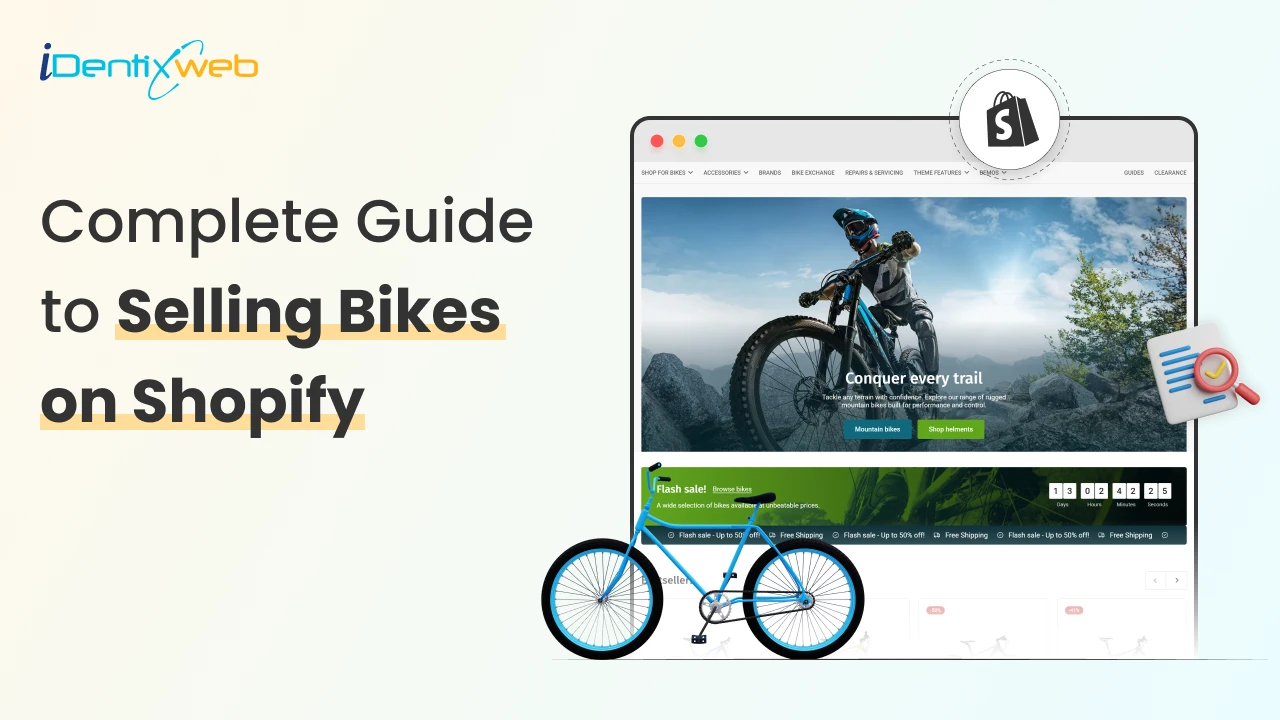
Have you noticed how bike stores using Shopify are absolutely crushing it in 2025? There are close to 14,000 bike stores currently live on Shopify (Source: Storeleads)
If you want to sell bikes or accessories, this is the moment to tap into that momentum and build a store that grows with you.
In this guide, we’re breaking down exactly how bike stores using Shopify are winning right now. You’ll see real examples of brands doing it right, the features that help bike stores stand out, and the conversion-focused strategies that make a real impact.
What Should I Keep in Mind Before Selling Bikes on Shopify?
- Define Your Niche Clearly
Whether you’re focusing on mountain bikes, road bikes, or electric bikes to sell on Shopify, having a clear niche helps you design better collections and messaging.
- Organize Your Product Catalog Smartly
Bike shoppers expect multiple sizing, color, and accessory options. This means your catalog needs to be structured clearly to help them compare without confusion.
- Use Variants and Specs the Right Way
Shopify’s variant system is perfect for bikes. But you still need clean descriptions, sizing charts, and strong imagery to support confident buying decisions.
- Prepare for High-Volume Customer Questions
Bikes, especially electric bikes, come with detailed questions about warranty, battery life, assembly, and delivery. An AI chatbot for a Shopify bike store can handle most of this instantly.
- Plan Your Shipping and Fulfillment Early
Bikes are heavy, fragile, and expensive to ship. Set up Shopify’s shipping apps to automate labels, tracking, and real-time carrier rates before you launch.
- Build Trust With Proof and Transparency
Bikes are high-ticket items. This is why shoppers need reviews, comparison tables, warranty info, FAQs, and real product photos before they hit “Buy.”
Bike store owners on Shopify face the ultimate challenge.
When a customer adds a bike to their cart, the opportunity for additional sales, such as accessories or upgrades is often lost.
This is because the cart experience is generic and not optimized for cross-selling.
Shopify upsell apps like iCart transform your cart with built-in widgets for product recommendations and cross-sells.
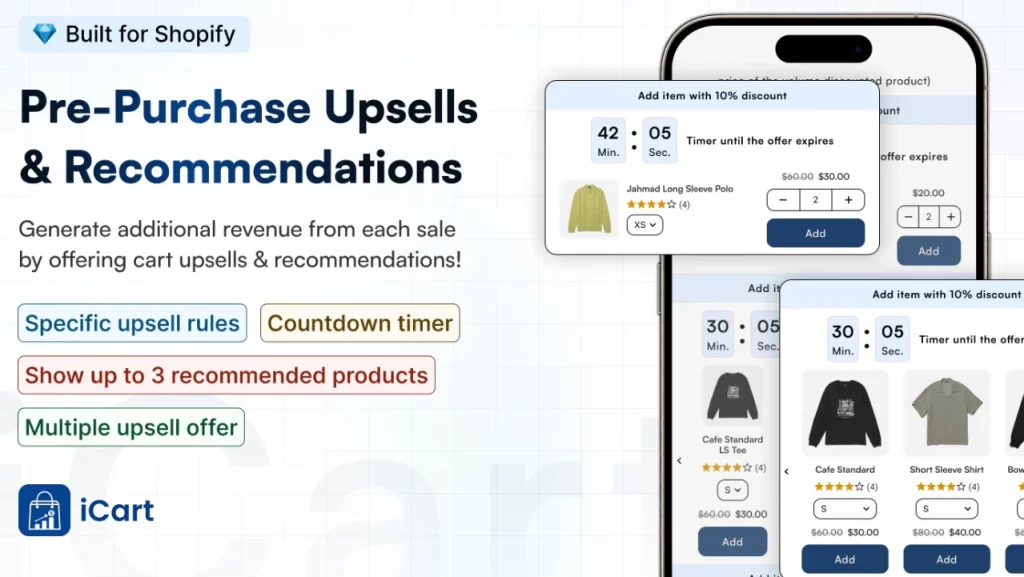
For a bike store, this means: when a customer adds any bike, iCart can immediately show “Complete your ride” accessory recommendations. This helps to increase cart size without forcing a separate upsell funnel
Examples of Bike Stores Using Shopify
State Bicycle Co.
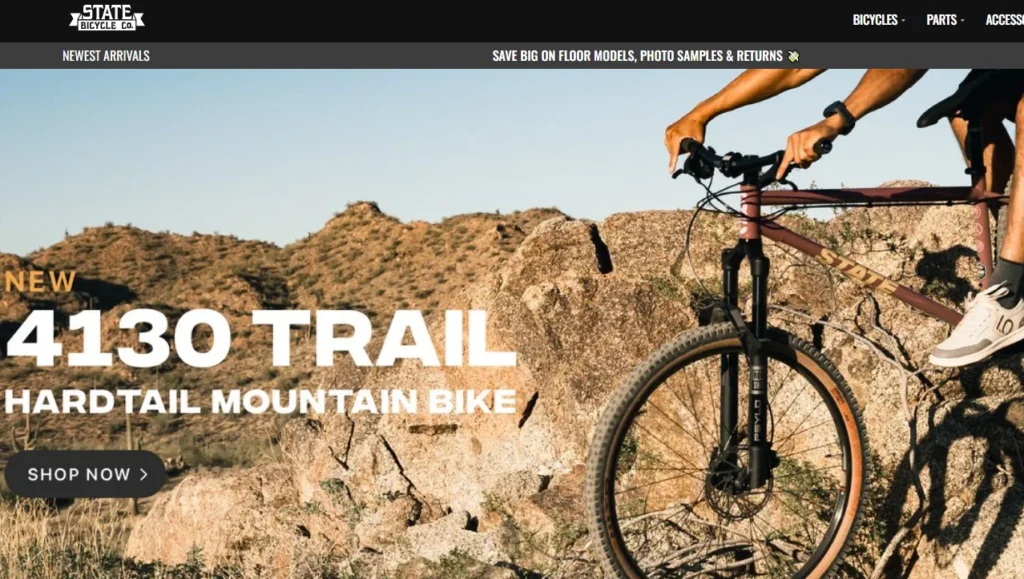
This is one of the best examples of bike stores I have come across that used Shopify to build their brand. When they upgraded to Shopify Plus, they gave their customers options to build their own custom bikes right in the store.
State Bicycle Co. has a great case study on how Shopify Plus helped them pull data from thousands of SKUs so that personalization became easy for customers. This helped them increase their revenue by more than 500%.
Worldwide Cyclery

A huge range of mountain bike parts, components, and upgrades: forks, shocks, drivetrains, brakes, wheels, tires, cockpits, and more, all geared toward serious MTB riders.
What I love about this bike store:
- I love how they build trust and reassurance everywhere in their store. Free U.S. shipping on everything, “Why Shop With Us?”, returns, demo bike program, custom builds, and an affiliate program are linked right from the homepage and footer.
- The navigation is insanely well-structured for bike enthusiasts.
Condor Cycles
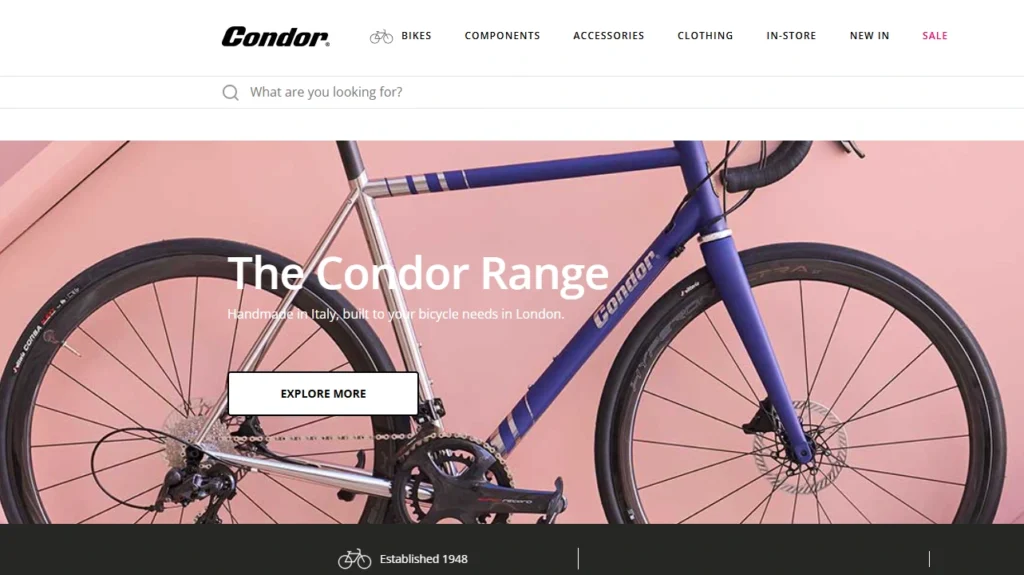
Handmade Condor bikes and framesets, built in Italy and finished to rider specifications in London.
What I love about this bike store:
- The site leads with brand story and heritage: “Handmade in Italy, built to your bicycle needs in London” and “Established 1948”. Both these taglines immediately set a premium, legacy tone that builds trust.
- They do a great job of connecting online and offline with clear “Book an Appointment,” “Bike Fitting,” “Visit Us,” and “Store Events” entries which are ideal for a Shopify bike store that runs a physical shop as a hub.
Schwinn
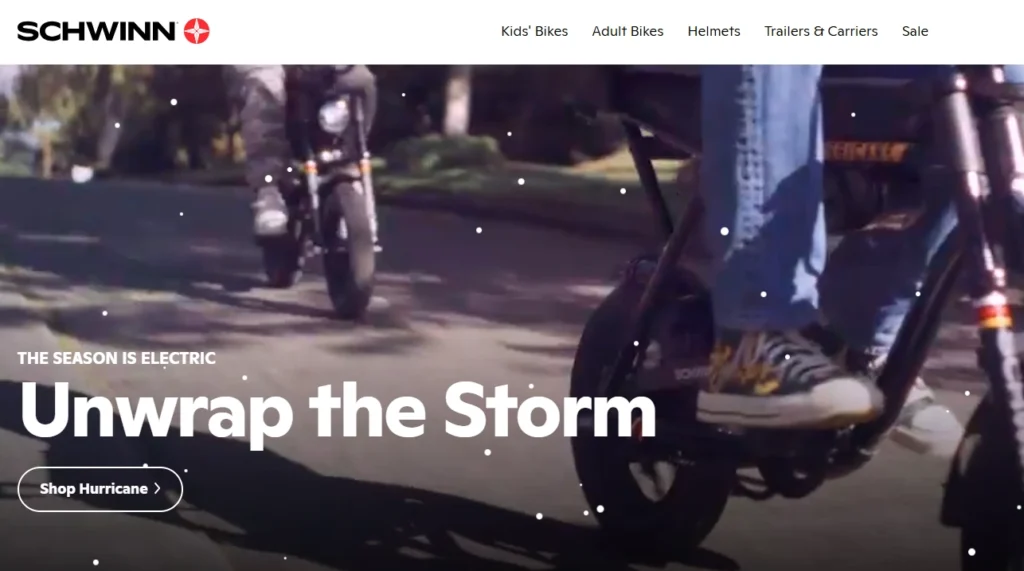
Schwinn sells bikes across categories such as electric, mountain, fitness, cruiser, commuter, comfort, and classic. They also sell a full range of helmets, trailers, and carriers.
What I love about this bike store:
- The navigation is built around how people actually shop: by rider type (kids/adults), riding style, and even rider height/age, which makes discovery feel effortless.
- The homepage merchandising has clear hero banners, seasonal messaging, and “Gifts for Kids/Gifts for Adults” sections that feel like curated collections.
- Strong trust-building blocks in the footer (returns, warranty, help center, manuals, retailers) make it feel like a safe place to buy.
Rad Power Bikes
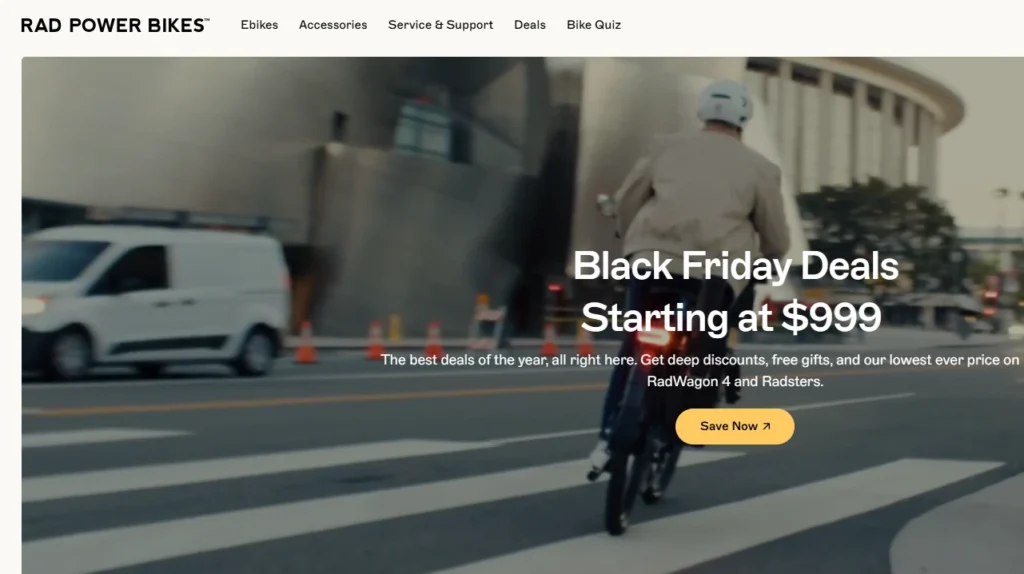
Rad Power Bikes has a focused lineup of electric bikes categorized by use case: off-road, cargo & utility, city & commuter, folding, step-thru, mid & fat tire, trike, and lightweight.
What I love about this bike store:
- I loved the mega-menu in this store, which is a textbook feature that all DTC brands need.
- Accessories, parts, and batteries are organized in a way that makes upsells feel natural. Bags, racks, lights, helmets, and range extenders are all bundled logically instead of being jammed into one cluttered page.
Cane Creek

Cane Creek is renowned for its high-end cycling components: headsets, suspension seatposts, cranks, shocks, forks, bottom brackets, cockpit parts, and brakes.
What I love about this bike store:
- Product navigation and “shop by ride style” live side by side, so both pros and enthusiasts can find their way quickly.
- Their use of color, lifestyle photography, and product shots gives a premium, engineering-led feel that really shows the quality of their bikes.
Envy Electric Rides

This store has a curated lineup of electric vehicles for urban mobility: electric motorcycles, electric unicycles, electric skateboards, and electric scooters.
What I love about this bike store:
- I love how their copy leans into benefits (“cut your commute in half,” “ride farther with confidence”) instead of just listing specs. This is a great way to showcase bikes on Shopify stores.
- Navigation is clean and category-first motorcycles, unicycles, skateboards, scooters, and reviews, so it feels more like a guided showroom than a generic catalog.
Why Should You Choose Shopify to Sell Bikes?
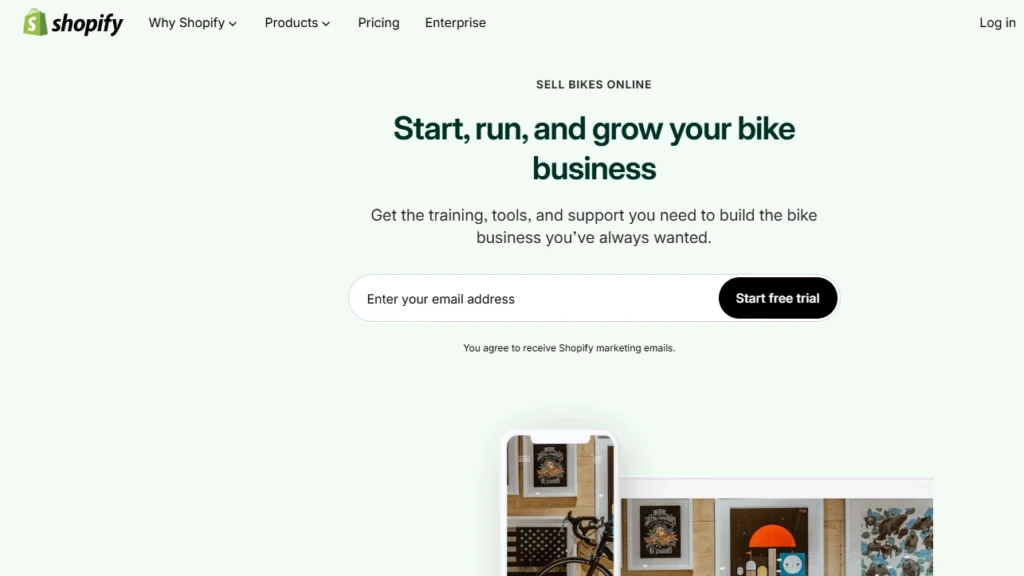
- High-Converting Shopify Themes for Bike & E-Bike Stores
You get mobile-optimzied and fast Shopify themes that help shoppers browse specs, compare models, and explore options smoothly. This is something bike buyers expect before spending big.
- Shipping Tools Made for Large & Heavy Products
From real-time carrier rates to automated labels and tracking, Shopify handles the heavy lifting for oversized shipments like bicycles and electric bikes.
- Shopify Apps Tailored for Bike Sellers
With apps for product customization, service bookings, upsells, bundling, and customer support, Shopify gives bike stores everything needed to handle the buying journey.
- Strong SEO Foundation for Organic Traffic
Shopify is built to help bike stores rank on Google with fast load times, clean URLs, built-in optimizations, and structured product pages.
Conclusion: Choose Shopify for Bike Stores
Shopify gives bike stores the flexibility, speed, and tools needed to sell high-ticket products online without adding complexity.
With Shopify, you get a platform built for growth, from Shopify apps to themes made for large items. As your store scales, Shopify scales with you, whether you're running a small bike store or expanding into multiple regions.
If your goal is to build a bike store that converts well and stands out in a competitive market, Shopify is the platform that gives you the best chance to grow.
Bike Stores using Shopify FAQs
1. Can I sell bikes on Shopify?
Yes, you can absolutely sell bikes on Shopify, including standard, custom, and electric bikes. Shopify gives you product variants, secure payments, and shipping integrations that make it practical to sell high-ticket items like bikes online.
2. How to sell bikes online?
To sell bikes online, you need a well-structured store with clear product categories, sizing guides, high-quality images, and detailed specs for each model.
3. What are the types of bikes I can sell on Shopify?
You can sell almost any type of bike on Shopify, including road bikes, mountain bikes, gravel bikes, hybrids, commuter bikes, kids’ bikes, folding bikes, and electric bikes.
4. What are the examples of the best bike stores using Shopify?
Well-known brands like Schwinn, Rad Power Bikes, and Cane Creek use Shopify to power their online stores. They showcase everything from kids’ bikes to high-end components and electric bikes.
5. Which bike accessories can I sell on Shopify?
You can sell helmets, locks, lights, racks, fenders, bottle cages, bags, panniers, pumps, tools, apparel, and even replacement parts like chains, tires, tubes, and saddles.
6. Which AI chatbot is best for Shopify bike stores?
Popular AI chatbot tools for Shopify bike stores include apps like Tidio, Gorgias, and similar AI-powered support tools that plug directly into Shopify.
7. How should I price my bikes when I sell them online?
Start by calculating your true costs (product, shipping, fees, marketing, and servicing) and then benchmark against comparable brands in your niche to find a competitive but profitable price point.


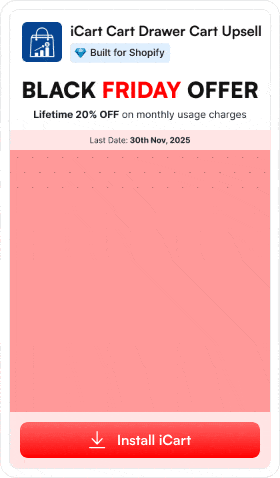
![The 20 Best Shopify Beauty Store Examples [Latest Update] The 20 Best Shopify Beauty Store Examples [Latest Update]](https://www.identixweb.com/wp-content/uploads/2025/11/14-11-Fri-Blog-The-20-Best-Shopify-Beauty-Stores.webp)
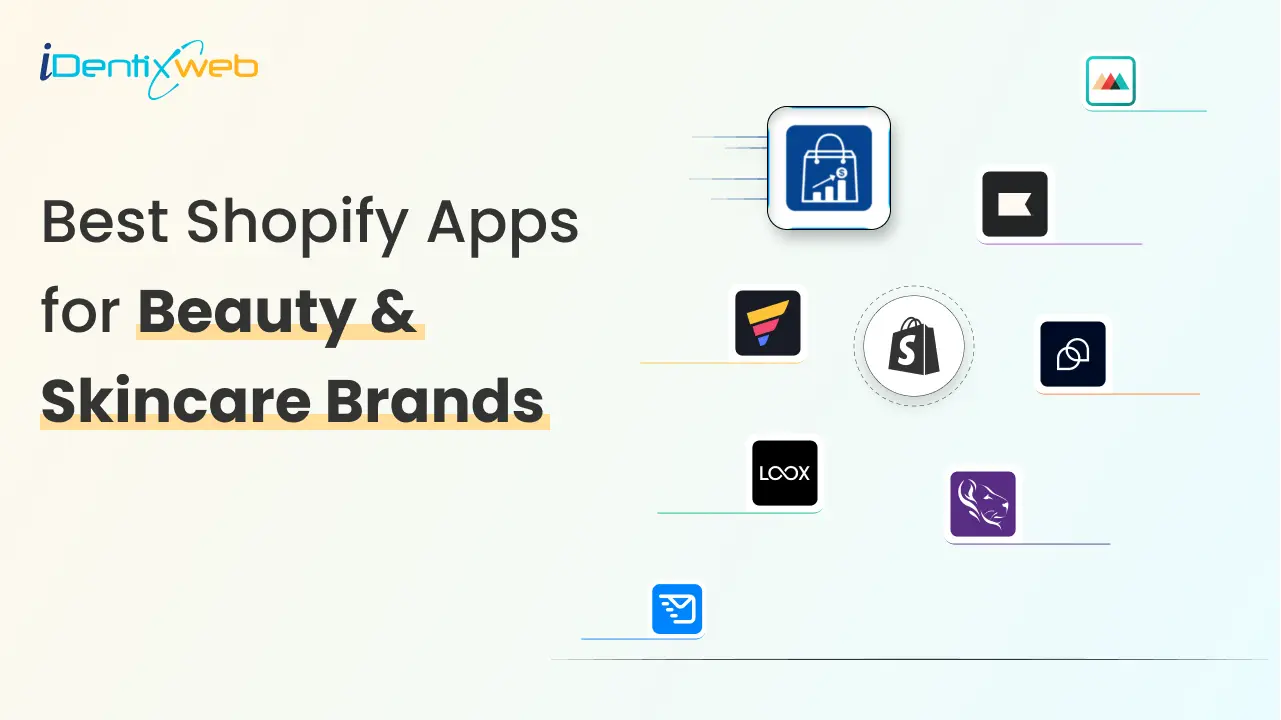
![How to Create Shopify Bundles With & Without an App [2025] How to Create Shopify Bundles With & Without an App [2025]](https://www.identixweb.com/wp-content/uploads/2025/11/10-11-Mon-Blog-How-to-Create-Shopify-Bundles_-With-Without-a-Shopify-App.webp)

About the author
Vineet Nair
Vineet is an experienced content strategist with expertise in the ecommerce domain and a keen interest in Shopify. He aims to help Shopify merchants thrive in this competitive environment with technical solutions and thoughtfully structured content.